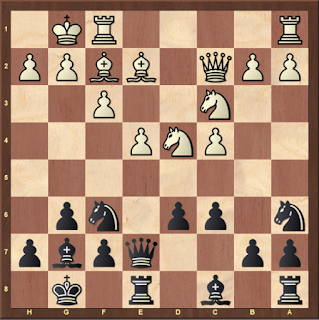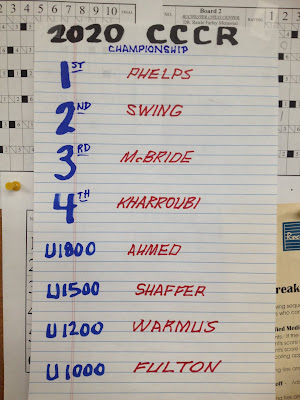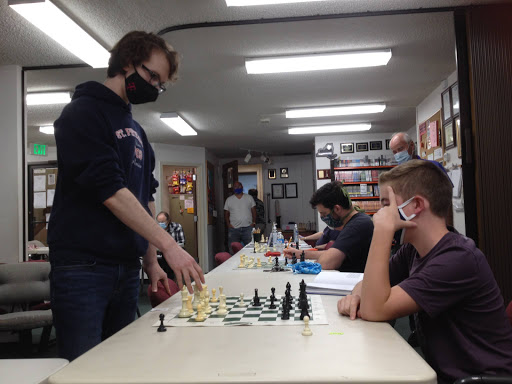Welcome to our Chess Blog! We post local chess news, chess tournament announcements (TLAs), game analysis and chess links. You are encouraged to visit the Chess Center in Rochester New York where we run chess tournaments, give chess lectures and host special events. For more information, you may contact the club at 585-442-2430. The Address is: 221 Norris Drive, Rochester New York 14610. We are the Community Chess Club of Rochester (CCCR) and our US Chess Federation Affiliate ID is A6000220.
Sunday, December 27, 2020
CHESS CAMP Dec 28-31 at the Chess Center!
Saturday, December 26, 2020
Dr. Rawle Farley Memorial Monday Night League begins Jan 4th
Hello everyone and happy holidays (however you celebrate).
If you are interested, please call or e-mail to let us know. Pre-registration is NOT required — you can simply show up — but every little bit of advance information helps.
Otherwise, chess activities continue. The Chess Center itself was closed Dec. 24 and 25, and it will be closed Jan. 1 but it is open every weekday. Wednesday’s the Community Chess Club continues to meet, and Saturday tournaments continue as well.
Also, if you know youths who might be interested, the Chess Center is running chess camps next week (Monday through Thursday (Dec. 28-Dec. 31).
For all Chess Center activities, COVID safety protocols remain in place: masks, social distancing, disinfecting/sanitation, and a request to self-quarantine if you’ve felt ill.
If you’d like to be removed from e-mail notices, or you wish to change your e-mail address, please let us know.
Stay safe, be well and we look forward to seeing you soon.
Thursday, December 24, 2020
Online Chess Lessons available now on our club's Youtube channel
No tournaments to play in? Worried about your chess getting rusty? Enjoy four online chess lessons produced by the Community Chess Club of Rochester this past summer. In the four lessons we have about 8 hours of FREE chess instruction with some of the highest rated instructors in upstate New York. If you missed the online Zoom meeting when we did these lectures live online, you now can enjoy the recorded lessons on our club's Youtube channel.
Instructors: Lev Paciorkowski, Clif Kharroubi & Ken McBride
Lesson 3: Chess Misconceptions
Lesson 4: Grandmaster Blunders & Bonus: Lev demonstrates the Knight's Tour
Wednesday, October 28, 2020
David Phelps wins the 2020 Club Championship!
Congratulations to
 |
| Round 4 with David Phelps (left) and Henry Swing |
 |
| 2020 CCCR Championship Participants |
 | |
|
 | |
|
Final Standings:
 |
| Jamshed Ahmed (right) won his game against TJ Weaver. |
 |
| Ryan Beh (right) won his game against Don Stubblebine. |
will be held at the Rochester Chess Center
Thursday, October 22, 2020
2020 CCCR Club Championship: Round 3
Saturday, October 17, 2020
2020 CCCR Club Championship: Round 2
Round 2 was held on Wednesday, October 14, and as usual there was plenty of excitement! We had a turnaround upset on board 2, and at one point I had an objectively lost position on board 1. Let's dive into the games.
Let's start with our game of the week, which was Henry Swing's (1936) win over Clif Kharroubi (2098), overcoming a more than 150 point rating gap.
Saturday, October 10, 2020
2020 CCCR Club Championship: Round 1
Round 1 of the 2020 Club Championship was held last Wednesday on 10/07. This year I'll be spotlighting one game from each round (typically an upset) and analyzing it.
Even with many of the boards seeing large rating disparities in round 1, we had at least two very significant upsets, one of which I've gotten the game score for.
The first was Vinnie Basile's (1212) win over Greg Miller (1820), which I have as the game of the week below:
Friday, October 2, 2020
2020 Club Championship
The 24th Annual Community Chess Club Championship
Wednesday, September 9, 2020
My Games from the 2020 New York State Championship
The 2020 New York State Chess Championship was held online this year from September 5-7 on the Internet Chess Club. With a combination of good opening preparation, tactical awareness and a little luck I managed a clean 6-0 sweep! I've selected a few of my games to analyze.
Let's start with round 2, which was definitely my sloppiest game of the event:
Paciorkowski, Lev (2443) - Ehsani, Yassamin (2095); Round 2
 |
| White to move |
The opening has gone rather adventurously and my king did not end up finding a secure home. So naturally, I was very relieved in this position to be able to play 19.Qg5 trading the queens. After 19. ... Qxg5 it is difficult to say which recapture is best, but I went with the more ambitious one 20.fxg5!? gaining a tempo to win the b5 pawn: 20. ... Nf5 21.Bxb5 Be6 (D)
 |
| White to move |
White is up a pawn but the pieces are so badly coordinated that black has pretty good compensation. My advanced kingside pawns have some cramping effect, but they also could turn out to be weaknesses, so this is double-edged. The game continued 22.Ke2 Rac8 23.Bd3 Bb6 24.Rc1 Rxc1 25.Bxc1 Rc8 26.Nf2 and now 26. ... d4! 27.e4 Ne3 (D) upped the stakes even more.
 |
| White to move |
Black has gotten the so-called "octopus" knight on the third rank, and things do not look so rosy as there is also a threat of ...Rc5-xe5 regaining the pawn. I can play 28.Bxe3, but after 28. ... dxe3 neither 29.Ng4 Bxg4+= nor 29.Nd1? Rc1! -+ are what I want. However, it turns out that white has a surprising idea in this position. 28.Bb2! Preventing Rc5 by attacking d4... 28. ... Bd7 ...so black naturally prepares Re8-xe5 instead. 29.Bb1!? Re8 30.a4! Rxe5 31.Kd3! Now the point of 30.a4 becomes clear: it was necessary to prevent ...Bb5+ in this position. I at first thought white was just winning, because the threat is Bxd4 when the Ne3 is suddenly trapped. I then realized black has an only move, which my opponent found: 31. ... Re6! planning a pin if I take on d4. Things are once again far from clear and after 32.Ba2 Rc6 33.Rc1 Rxc1 34.Bxc1 (D) I actually offered a draw, having just 7 minutes to my opponent's 39 minutes (time control is G/90 + 10).
 |
| Black to move |
It looks like black has all the cards with a superb knight and lots of weak pawns to attack on the kingside. My engine assures me this is still equal, but during the game I thought black was simply much better. At this point I had an unbelievable stroke of luck: my opponent declined the draw, and then in four moves managed to give himself a lost position! 34. ... Ng2 35.Bd2 Bc7 36.h3 Nf4+? 37.Kxd4! Nxh3+? 38.Nxh3 Bxh3 39.b4! (D)
 |
| Black to move |
On move 36 something like ...Be6! would have been much stronger, maintaining the tension and freezing my queenside. Now white's active king, 2-1 queenside majority and black's inability to make a passed pawn on the kingside give me a decisive advantage. With 5 minutes left I was able to convert: 39. ... Kg7 40.e5 stopping ...f6 Kf8 41.a5 Bf1 42.Bf4 Ke7 43.Bc4 Bg2 (43. ... Bxc4 44.Kxc4 is winning for white: 44. ... Ke6 45.Kc5 Kf5 46.e6! +-) 44.Bd5 Bf1 45.Kc5 Ba6 46.Kc6 Bb8 47.Bxf7 Bd3 (47. ... Kxf7 48.e6+ Kxe6 49.Bxb8 +-) 48.Bd5 Ba6 49.Bf3 Bc8 50.Bg2 Ba6 51.Bh3 Kd8 52.b5 Bc8 53.Bxc8 Kxc8 54.e6 1-0
 |
| Black to move |
As a result of Jason's 9th move, we have gotten into an open KID structure. These positions are known today to be simply better for white, and black basically shuffles his pieces around playing for tricks. White's main plan is to start a pawn roller on the kingside: h2-h3, then f3-f4 and g2-g4 to gain more space. I wasn't very comfortable in this position, but in any case the game continued...
 |
| White to move |
The first critical moment. Here I was most concerned about 19.f4! Ned7 20.g4!, which gives white a serious plus - it exposes the king but black lacks the piece coordination to properly take advantage of it. Instead white played 19.Nc2? allowing the thematic sacrifice 19. ... Bxh3! 20.Qxd6 (20.gxh3? Nxf3 21.Qxd6 Nxe1 -+ is bad for white; so is 20.f4?! Bg4! 21.fxe5 Bxd1 22.Rxd1 Rxe5! -/+ 23.Qxd6?? Rh5+ 24.Kg1 Be5 -+) 20. ... Bf8 21.Qf6 Bg7 22.Qd6 Bf8 (I calculated 22. ... Ncd3? for a while before finally realizing it just loses after 23.Bxd3 Rad8 24.Qb4! +-) 23.Qf6 Bc8!? declining the repetition; black has exchanged his weakness on d6 for white's valuable h3 pawn, so there is no reason not to continue playing.
 |
| Black to move |
After declining two draw offers in the opening, we reached this interesting position. Early on I had sent my h-pawn all the way up to h6, but the main question here is whether or not that pawn is a strength or a weakness. I had just castled last move, so there is no longer a rook defending it.
 |
| Black to move |
By far the strongest recapture. I actually think white is already just winning in this position, since black has no way to stop the d4-d5 break, when the center blows open and the king on g8 comes under attack. The Nc6, Bd7 and Qe7 are on perhaps the worst possible squares, as they will only be targets after I put my rooks on e1/d1 and push d5.
 |
| White to move |
With all pistons firing, white is ready to go: 23.d5 exd5 (23. ... Nxd5 24.Bxf6+ Rxf6 25.Qxf6+ Nxf6 26.Rxd6 +-) 24.Bxf6+ Rxf6 (24. ... Qxf6 25.Qxf6+ Rxf6 26.Rxe7 dxc4 27.Rdxd7 +-) 25.Bxd5! From move 23 it had taken me a few minutes to appreciate the strength of this simple recapture, but once you see it, it becomes clear that black is lost. The threat is Be6 or Re6 which cannot be stopped except for 25. ... Nxd5, allowing 26.Rxd5 Qf8 (26. ... Qc6 27.Rxd7) 27.Rxd7! Rxd7 28.Qxf6+! winning. On 25. ... Rf8 I had also seen the cute interference 26.Bf7! +-.
Monday, August 31, 2020
Simul 2020 Results!
The 2020 CCCR Simul was held on Wednesday, August 26, 2020 at the Rochester Chess Center. In this post I will just briefly summarize the results and comment on some of the games and my playing strategy throughout the event.
Be sure to also check out some photos from the event at our Photo Gallery
Even with the social distancing and safety procedures, we still were able to have 14 players with all spots filled! Although my opponents fought valiantly, in the end I managed to squeeze out 14 full wins after about 2 hours.
Many of the games were quite interesting! To start, let's have a look at what I think was the most instructive one. Coincidentally this was also the game where I felt like I thought the most:
I played the opening very quickly, but Ryan played well in response, getting a perfectly decent position with black after 15 moves. This may not sound like a big deal but it is an important step to making my life harder in a simul! In many other games I was able to get a superior or outright winning position from the opening and then convert the advantage on autopilot. When I have no advantage though, I need to think a little on how to pose problems for my opponent and induce some mistakes, which may mean taking some risks on my own position. Indeed, had Ryan found 16. ... c4!, I could easily have found myself in trouble.
Perhaps contrary to expectations, in most of these games I never calculated more than 4 or 5 half-moves ahead. The exceptions are notable though; in two of the games I did need to do some moderately deep calculation:
And the following game as well:
Finally, the last game I'll analyze here contains probably the most amusing moment of the simul: I flat-out missed capturing a free rook!
Probably for the best, I remained blissfully ignorant of my oversight until after all the games were done.
In what seems to be a new feature, chess.com offers some interesting statistics when analyzing games -- to close out I'll share this on the 13 games that we recovered the notation for:
- Total time: ~ 2 hours
- Total moves played: 471 (by me only)
- Average time per move: 15 seconds
- "Best" move: 254 / 471 (54%)
- "Excellent" move: 77 / 471 (16%)
- "Good" move: 53 / 471 (11%)
- "Book" move: 54 / 471 (11%)
- "Inaccuracy": 18 / 471 (4%)
- "Mistake": 12 / 471 (3%)
- "Blunder": 1 / 471 (<1%)
- "Missed Win": 2 / 471 (<1%)
- Average accuracy score: 91%
Thank you very much to all participants and organizers! A lot of planning went into making sure this event would be safe and it was great to see the turnout that we had.
Wednesday, August 19, 2020
Member Games: Adventures in the Queen's Indian
Today we get to look at a highly instructive game played at one of the Saturday tournaments here in Rochester. It is the encounter Beh - Manning, played on 08 August 2020.
Friday, July 31, 2020
How to Calculate (2/2)
- After 2.Qh5 Qxd4 3.Ng5 h6, both my Ng5 and Ra1 are hanging. I can save both with 4.Be3 but then at the very least 4. ... Qg4 trades queens and ends my attack. Black is fine there.
- What about 2.d5!? - after 2. ... cxd5 3.cxd5 black cannot play 3. ... Qxd5? 4.Nf6+! (a tactic) so instead must play 3. ... Nxd5. I can keep going with 4.Ba3 Re8...what do I have in that position? Perhaps 5.Nd6 but then 5. ... Bxd6 6.Bxd6 Qxd6 7.Bxd5 and we have made too many trades, black can at the very least equalize there by returning the pawn with 7. ... Be6 8.Bxb7 Rad8.
- Going back to the position after 2.d5!? cxd5 3.cxd5 Nxd5 4.Ba3 Re8, how about 5.Nc5!? ... if black moves the Nd5 I take on b7, but maybe the position after 5. ... Be6 6.Nxe6 fxe6 is not too bad...yes, that's a strong knight on d5 now. Although white shouldn't be worse with the bishop pair and black's ugly e-pawns, I want to find something better...
- How about 2.Ba3 immediately? The rook only has one square: 2. ... Rf8. Hmm, now after 3.Qh5 I am threatening the deadly Ne4-g5, double attacking h7 and f7 ... for example 3. ... Qxd4? 4.Ng5 and black is busted; 4. ... Bf5 5.Qxf7+ and 6.Qxf5, or 4. ... h6 5.Qxf7+ and 6.Qxe8 wins for white
- So that means after 2.Ba3 Re8 3.Qh5 black must stop Ne4-g5. There are not many ways to do that; 3. ... f6 looks very dubious so probably black must try 3. ... h6 instead.
- In that case, after 2.Ba3 Re8 3.Qh5 h6 maybe I can try 4.d5 there; I am threatening d5-d6 or simply Rad1 with a crushing position, so black has to try taking: 4. ... cxd5 5.cxd5, but now once again 5. ... Qxd5? 6.Nf6+! wins on the spot, so how about 5. ... Nxd5 instead? In that position, the d-file is open, so I can continue with 6.Rad1, threatening Rxd5 followed by Nf6+, winning. What can black do about that?
- So, after 2.Ba3 Re8 3.Qh5 h6 4.d5 cxd5 5.cxd5 Nxd5 6.Rad1, black must do something to stop my threat - 6. ... Nf6 is no good because of 7.Rxd8 Nxh5 8.Rxe8+. The queen cannot move though; on any queen move I still have 7.Rxd5. Perhaps 6. ... Kh8, that would stop 7.Rxd5 Qxd5 because 8.Nf6 is no longer check. Instead though, after 6. ... Kh8 I could do something simple like 7.Nc3. The Nd5 is triple attacked and only defended once; if it doesn't move I will simply take it next turn and 7. ... Nf6 is still met by 8.Rxd8 Nxh5 9.Rxe8+, winning
- OK, so 2.Ba3 Re8 3.Qh5 h6 4.d5 cxd5 5.cxd5 Nxd5 6.Rad1 ... hm ... since ...Kh8 and ...Nf6 don't work, the knight must be defended; only way is 6. ... Be6. What do I have there? Maybe 7.Nc5 again? After 7.Nc5 b6 8.Nxe6 fxe6 once again I've just reinforced that knight on d5; white shouldn't be worse but I want more than that.
- 2.Ba3 Re8 3.Qh5 h6 4.d5 cxd5 5.cxd5 Nxd5 6.Rad1 Be6 ... maybe 7.Nc3, triple attacking the knight. But there black can get away with 7. ... Nf6 since his rooks are connected: 8.Rxd8 Nxh5 9.Rxe8+ Rxe8 and black is fine.
- 2.Ba3 Re8 3.Qh5 h6 4.d5 cxd5 5.cxd5 Nxd5 6.Rad1 Be6 ... black's position is quite shaky here ... is it crazy to try 7.Rxd5!? After 7. ... Qxd5 8.Nf6+ wins again, so that means 7. ... Bxd5 is forced. Now I play the other rook 8.Rd1, again threatening Rxd5 and Nf6+. What on earth can black do about that?
- So my main line right now is 2.Ba3 Re8 3.Qh5 h6 4.d5 cxd5 5.cxd5 Nxd5 6.Rad1 Be6 7.Rxd5 Bxd5 8.Rd1 ... OK, any queen move and I can simply play 9.Rxd5 - for instance 8. ... Qd7 9.Rxd5 Qxd5 10.Nf6+ gxf6 11.Bxd5 and what's material there ... I have queen and bishop for two rooks, and black's king is weak - should be winning for white.
- After 2.Ba3 Re8 3.Qh5 h6 4.d5 cxd5 5.cxd5 Nxd5 6.Rad1 Be6 7.Rxd5 Bxd5 8.Rd1, what else could black try there... what about 8. ... Kh8 again - a funny move but it stops my main threat, since Nf6 is not check anymore. But there again I could just play 9.Nc3. If you let me take on d5 I have two minors for a rook, should be close to winning position. The only other try is to sac the queen with 9. ... Bxg2 10.Rxd8 Raxd8 11.Kxg2. There again I have queen and minor piece for two rooks; that's winning.
- So what's left? After 2.Ba3 Re8 3.Qh5 h6 4.d5 cxd5 5.cxd5 Nxd5 6.Rad1 Be6 7.Rxd5 Bxd5 8.Rd1, ...Kh8 is no good, queen moves are no good, maybe 8. ... Bc6 but then still 9.Rxd8 Raxd8 with Q+N for two rooks; that's decisive. If 8. ... g6 then just 9.Qxh6, that doesn't help black at all. OK, this line is good for me, so black must find something else earlier.
- After 2.Ba3 Re8 3.Qh5 h6 4.d5 cxd5 5.cxd5 Nxd5 6.Rad1 Be6 7.Rxd5 the only move other than 7. ... Bxd5 is 7. ... Qxd5 and sac the queen: 8.Nf6+ gxf6 9.Bxd5 Bxd5; there black has rook and bishop for the queen, but wait, the line continues: I have 10.Qg4+ Kh7 and 11.Qd7, picking up a bishop, so white should be easily winning there.
- So I suppose then after 2.Ba3 Re8 3.Qh5 h6 4.d5 cxd5 5.cxd5, black cannot play 5. ... Nxd5 because 6.Rad1 is just too strong. 6. ... Be6 7.Rxd5 is winning for white, but there is nothing else there for black to meet both Rxd5-Nf6 and the simple Nc3.
- In that case, my main line is 2.Ba3 Re8 ... that's forced ... 3.Qh5 h6 ... that's also forced, to stop Ng5 ... 4.d5 cxd5 5.cxd5. If black cannot play 5. ... Nxd5 then my next moves are either d5-d6 or Rad1, which looks like a nearly winning position for white.
- Technical Errors - for example the "ghost piece": after Bc1-a3 you try to move the bishop again from c1 to g5 later in a variation; or after a piece gets captured you still try to make moves with it on the board. This is very common, and I've even seen GMs do this on occasion!
- Tactical Errors - overlooking a tactical shot in a variation in your head. Everybody is vulnerable to this, even masters and grandmasters.
- "Blind spots" - This can vary from person to person. For instance, do you often miss sideways queen moves or backwards moves (many people struggle with those). Or maybe you frequently overlook simpler "quiet" moves. Regularly missing defensive resources or your opponent's counterplay could also be a blind spot.
- At the basic level, just start with having a friend tell you the name of a square on the chessboard. Without looking, say what color that square is (e.g. "c4: white").
- Find a friend and an empty chess board. Have your friend put any two pieces on the empty board on any two squares (color doesn't matter). Without looking, say if any of the pieces attacks the other. Then have your friend make a move with one of the pieces, telling it to you out loud. Repeat, saying if any of the pieces attacks the other, but without looking. This can be scaled up with more pieces for greater difficulty.
- Try to win a simple position (e.g. mate with king and queen vs. king) blindfolded against a friend, only saying the moves.
- Find any game and read through the first 5-10 moves. Then, go to a chess board and set up how you see the position resulting from those 5-10 moves, comparing it to how the position actually is.
Most of the time, I find that tactical and technical errors actually tend to go together, and the logic is straightforward: if the position is getting fuzzy, you're less likely to notice a key tactical idea. For this reason, training your depth will also tend to improve your ability to see tactics in any variations you analyze.
However, another solution is to simply practice solving basic tactical puzzles. All of these tactics are really just patterns, and pattern-recognition is something our brains are naturally good at. Those forks, pins, skewers, discovered attacks and basic checkmating patterns frequently repeat themselves throughout chess games, and simply taking the time to regularly solve puzzles - even just 15 minutes a day - will put you on the road to mastering them. Of the three kinds of errors here, tactical errors are the easiest to train. This is why one of the very first things I teach my students is how to solve tactics so they are able to find those simple one-move shots in a position.
- Backwards moves
- Long sideways queen/rook moves
- "Co-linear" moves (you move towards an opponent's piece but stop just short of capturing it)
- Quiet moves, particularly in non-quiet positions
- Forgetting about/overlooking opponent's counterplay

























